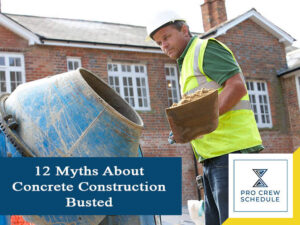Concrete is one of the most widely used materials in construction. Not only is it one of the strongest and most durable, but it also has its merits on cost-effectivity. But just because it’s considered a staple in the industry doesn’t mean that professional contractors and concrete workers know absolutely everything about it– some misconceptions might have even hindered them from getting the best out of it.
Concrete Software for Contractors
Contractors might be the ones in charge, but there are some things they can’t do or even know about. That’s why having a solid field crew is beneficial on their part, especially for large general contracting jobs. With their skills and knowledge, contractors might discover innovative ways to operate, correct their mistakes, and clear some misconceptions they had.
Construction scheduling software is a handy tool for contractors. With a big crew to manage, concrete contractors could use all the help they could get. Laborers can work under a builder schedule to improve organization and increase efficiency; Contractors can use project management tools to keep track of the whole project, from wisely using materials to fixing construction schedules. With a good subcontractor scheduling software, the project will progress smoothly and be completed successfully.
2 Concrete Construction Myths
Myth #1: Concrete is impermeable
Fact: The common belief is that concrete is so solid that it allows not liquid to pass through. But the truth is that it is, at some level, porous, even the densest ones. This means that water and other substances can still pass through either in liquid or vapor form.
To reduce permeability, use mix designs with a low water-to-cement ratio, chemical admixtures (like plasticizers), and well-graded aggregate. Alternatively, surface treatments, like sealers, can also reduce absorption and permeability.
Myth #2: Concrete with higher strength is more durable
Fact: Strength and durability do not mean the same thing; ergo, higher strength concrete is not more durable. Although comprehensive strength is one of concrete’s notable characteristics, it alone does not determine its durability; other factors make it durable in harsh environments. On the other hand, the principal causes of concrete deterioration are alkali-silica reaction, corrosion of reinforcing the steel, and exposure to freeze-thaw cycles.
Even though concrete is not indestructible, it’s durability can increase by reducing permeability. Moreover, in areas of tension, structural reinforcement does not prevent cracking but holds crack faces together.
Myth #3: The only way to increase the slump is to add water
Fact: Essentially, slump measures the workability of concrete, and adding water is only one of the many ways to increase it. In fact, it has a few drawbacks to it, such as:
● Increases slump only by one inch;
● Increases shrinkage;
● Decreases comprehensive strength by up to 200 psi; and
● Wastes about a quarter of a bag of cement.
An alternative to using more water to increase the slump is to use a water reducer or superplasticizer while maintaining the water-to-cement ratio.
The aggregates’ grading and maximum size affect workability as it influences cement and water requirements. So, modify the gradations or proportions of aggregates back at the plant.
Throughout the day, measure and correct for variations and moisture content of aggregates. In addition to that, monitor long deliveries and unloading time as they can decrease slump. Maintaining and controlling quality from truck to truck can help identify reasons for differences in slump.
Myth #4: Water damages concrete
Fact: While concrete is not impermeable, it is not damaged by water– it is essential in concrete finishing.
Contrary to popular belief, curing is not a drying process; it is a process where water is vaporized. That’s why water is required to hydrate and strengthen concrete during the curing phase. The hydration of fresh concrete will continue so long as there is enough moisture in favorable temperatures and stops when it dries out, usually with relative humidity below 80%. Furthermore, fresh concrete that approaches freezing temperatures (below 5°C) dramatically slows hydration. Conversely, fresh concrete in high temperatures rapidly loses moistures and can increase the risk of cracking.
The longer concrete cures, the stronger and durable it will be. That’s why water and moisture are essential in concrete curing.
Myth #5: Concrete is not eco-friendly
Fact: The cement industry releases carbon emissions into the atmosphere, but concrete isn’t bad for the environment. Because it is one of the most durable and strongest construction materials on the market, it can last a very long time. This means that there will be minimal to no major repairs, no additional material will be used, and less energy will be consumed.
However, most of the energy consumed by a building is from the electricity used from within, not from construction.
Myth #6: Reinforced concrete will not crack
Fact: Ideally, structural reinforcement would make that building so structurally sound that it can prevent cracking. But in reality, even with reinforcement, concrete that does not move during volume changes, like setting and drying, can crack because it is weak in tension areas. The role of structural reinforcement is not to prevent cracking but rather to hold the crack faces together.
When cracking in concrete happens, the tensile stress is transferred to the steel from the concrete. This allows reinforced concrete to hold up against a higher tensile load than just concrete alone.
Myth #7: Concrete is cold
Fact: Thinking that concrete is cold is a common misconception; that’s why many people in hot places prefer concrete finishes.
However, concrete/cement absorbs and retains heat well and gradually releases it throughout the day. This feature of concrete makes it warmer than tiles.
Moreover, concrete floors are an excellent option to consider when thinking about underfloor heating. If you opt for this, the first stages of using the system will need a bit of care. Because it is critical to maintaining the finish, there needs to be ample time for the concrete to cure before turning the heating system. Over the next few weeks, the temperature should gradually increase.
Myth #8: It’s easy to DIY concrete jobs
Fact: The idea of doing a concrete job yourself might be tempting because there are pre-mixed bags available and an abundance of online tutorials. But to DIY a concrete job, you’ll need the skills and knowledge to finish the project successfully. It’s always better to seek the help of professionals to do the job for you.
Myth #9: The number of bags of cement can specify a concrete mix
Fact: To be clear, performance requirements should specify mixes and not cement content alone. Additionally, it’s essential to consider the water-to-cement ration, one of the most vital concrete mix properties. For example, one of these requirements is the minimum comprehensive strength, which is influenced by the amount of water in the concrete mix.
Specifying bags of cement without considering the amount of water is not a specification at all– you can’t decide on anything with just cement in mind.
Myth #10: Fresh concrete that is flat and level will remains so after hardening
Fact: Even though concrete is laid on flat and level, it can change shape while settling.
One of these changes is horizontal movement. This kind of shift happens because the temperature and moisture in a concrete slab changes.
Another alteration is curling, which is lifting the edges of a slab at the joints and cracks. Like horizontal movement, curling happens when there is a difference in the temperature and moisture content, specifically between the slab’s bottom and top.
Myth #11: Concrete finishing is a go if there is no visible water bleed
Fact: Concrete work is not simply slapping it on and waiting for it to dry; it takes a lot of experience, skill, time, and effort to start the finishing phase.
Bleeding has to be fully complete before finishing and begin. With that said, banking on the idea that bleeding has stopped when there is no water visible is not enough. Depending on the environment and concrete properties, there might still be bleeding even if it cannot be seen– the bleed water could evaporate as it reaches the slab surface.
Several problems could arise with improper finishing, such as dusting, crazing, blisters, and delaminations.
Myth #12: Calcium chloride is an antifreeze agent
Fact: Calcium chloride is not an antifreeze agent but merely an accelerator. So, utilizing this compound as an antifreeze agent can do more damage than good to the concrete.
If not adequately protected, the concrete can still freeze. Because concrete strengthens very slowly at cold temperatures, accelerators are used to quicken this development early on. An antifreeze agent’s importance is to protect fresh concrete from freezing until it reaches a minimum strength of 500 psi; otherwise, its strength will be reduced significantly.
To avoid concrete freezing, temperatures can be maintained with curing blankets, insulated forms, and enclosures.
The importance of an excellent concrete job
There are many reasons why busting myths are important. For these 12 concrete construction myths, the reasons are three-fold: better quality projects, a good reputation, and breaking the chain.
Actually, the reasons are connected, like steps to a plan. Contractors and concrete workers who want to deliver quality projects might fail to do so because these misconceptions prevent them. But if they can correct their “wrong” ways, they would be able to do better. In turn, they will make a good name for themselves. Then, the truth catches on and the chain of believing these myths can be broken.







